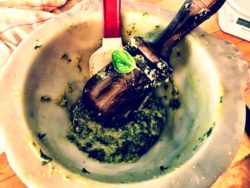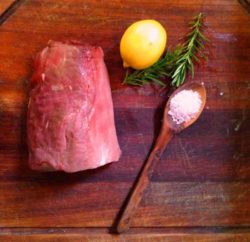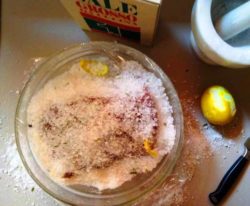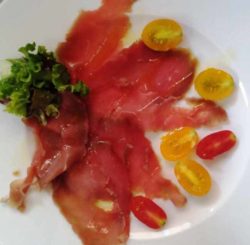Read Time: 4 Minutes Subscribe & Share
Hot And Cold
 Although we’re falling into fall, the balmy last days of September still call for hot weather cooking. So turn off the oven, but don’t
Although we’re falling into fall, the balmy last days of September still call for hot weather cooking. So turn off the oven, but don’t  start up the grill. Here’s a lovely way to serve silky tenderloin that requires no heat. Keep cool as a cucumber for a full-blown meal with Prosciutto, Taleggio and Melon Bites and Pesto Genovese.
start up the grill. Here’s a lovely way to serve silky tenderloin that requires no heat. Keep cool as a cucumber for a full-blown meal with Prosciutto, Taleggio and Melon Bites and Pesto Genovese.
A Meaty Adventure
It was 15 days before our flight to the US to visit family (the Before Times), and my son’s American passport had just expired. No problem, he can just travel with his  Italian one. Wrong. All American citizens must enter the US with an American passport. So from Bologna we went on a last-minute excursion to the US Consulate in Florence for an emergency renewal. There were a number of positive outcomes: new passport issued on the spot, avoiding all kinds of crazy car traffic with the new tram and the discovery of Trattoria Baldini. Right on the way back to the Leopolda tram station from the consulate, it is one of those places you discover out of logistic necessity. On the menu that day was a filetto sotto sale, salt cured tenderloin, which the waiter recommended. A room-temperature dish, perfect for the hot July day that it was. Like a roast beef without the roasting time. Silky, lush and possibly less hassle than making vitello tonnato, it seemed like a smart addition to the summer repertoire. So after a stream of compliments, the chef told us how he prepared it. Wrap a piece of beef, tenderloin being the best, in a mixture of salt and herbs and let it marinate for 24 hours in the refrigerator. What could be any easier, right?
Italian one. Wrong. All American citizens must enter the US with an American passport. So from Bologna we went on a last-minute excursion to the US Consulate in Florence for an emergency renewal. There were a number of positive outcomes: new passport issued on the spot, avoiding all kinds of crazy car traffic with the new tram and the discovery of Trattoria Baldini. Right on the way back to the Leopolda tram station from the consulate, it is one of those places you discover out of logistic necessity. On the menu that day was a filetto sotto sale, salt cured tenderloin, which the waiter recommended. A room-temperature dish, perfect for the hot July day that it was. Like a roast beef without the roasting time. Silky, lush and possibly less hassle than making vitello tonnato, it seemed like a smart addition to the summer repertoire. So after a stream of compliments, the chef told us how he prepared it. Wrap a piece of beef, tenderloin being the best, in a mixture of salt and herbs and let it marinate for 24 hours in the refrigerator. What could be any easier, right?
No-roast Roast Beef Recipe vs. Procedure
 Talking about cooking is one thing. When actually looking at a beautiful, expensive cut of meat in the confines of your kitchen, you might think twice before haphazardly wading in. Glossing over details or the omission of minor steps is why I’m generally a fan of written recipes, although I’ve learned over the years how to improvise. A little humbled before this formerly happy cow, I began to yearn for satisfaction-guaranteed instructions.
Talking about cooking is one thing. When actually looking at a beautiful, expensive cut of meat in the confines of your kitchen, you might think twice before haphazardly wading in. Glossing over details or the omission of minor steps is why I’m generally a fan of written recipes, although I’ve learned over the years how to improvise. A little humbled before this formerly happy cow, I began to yearn for satisfaction-guaranteed instructions.
None of my cookbooks has a recipe for no-roast roast beef. (Although that could change when Diane Henry’s Salt Sugar Smoke arrives). It’s not like it’s a traditional antipasto or a secondo that you’ll find in any Italian ricettario, despite similar cured beef variations like bresaola and carne salada, both from Northern Italy. Some lurking on food websites gave lots of results for tenderloin cooked in a salt crust (although these look equally exciting), but at that time almost nothing came up for a filetto crudo al sale.
The one recipe that did finally pop up on the list of search results came from the Italian Swiss broadcaster RS1. Chef Christian Frapolli’s Salt Cured Beef with Roasted Figs and Lamb’s Lettuce was the perfect first stab at this new method (watching the video in the recipe helped out too).
Goldilocks Quest
 Since that first attempt, I’ve played around with the quantities of salt for a just-right no-roast roast beef taste that would make Goldilocks happy. Frapolli’s recipe uses 2
Since that first attempt, I’ve played around with the quantities of salt for a just-right no-roast roast beef taste that would make Goldilocks happy. Frapolli’s recipe uses 2  lbs. of kosher salt, which we found excessive if not combined with the sweetness of the caramelized figs.
lbs. of kosher salt, which we found excessive if not combined with the sweetness of the caramelized figs.
I knew I was successful when my Italian sisters-in-law asked me how to make it. So here goes. For 500 grams or a bit over one pound of tenderloin, instead of 2 lbs. of kosher salt I use about 1 lb. Mix it together with ¾ lb of sugar, some chopped rosemary, whole black peppercorns and lemon zest. Pour half the mixture into the bowl, place the cut of beef on top and then pour the remaining salt mixture to fully cover. Seal with plastic wrap and cure for 24 hours in the refrigerator. After 24 hours remove the tenderloin from the salt, rinse, dry and brush with olive oil. I like it best sliced thin like prosciutto and served with salad or cherry tomatoes and a drizzle of olive. It is lovely too on toasted bread with sour cream. Consume it in 2-3 days.
I have used sirloin instead of tenderloin with equally good results. The important thing is that it is a quality, fresh cut. Make sure you trim any outside fat or nerves. The meat should also be as evenly thick as possible so it all cures at the same rate.

Juggling nuance between Italian and English, Tatiana lights up her five-burner kitchen top with nostalgia for American food, Bologna-inspired fare and cross-cultural inventions. She and her husband endlessly debate on cooking with or without a recipe. Their son just hopes that dinner will either be plain or have chocolate in it.




Comments are closed here.
Follow this link to create a Kitchen Detail account so that you can leave comments!